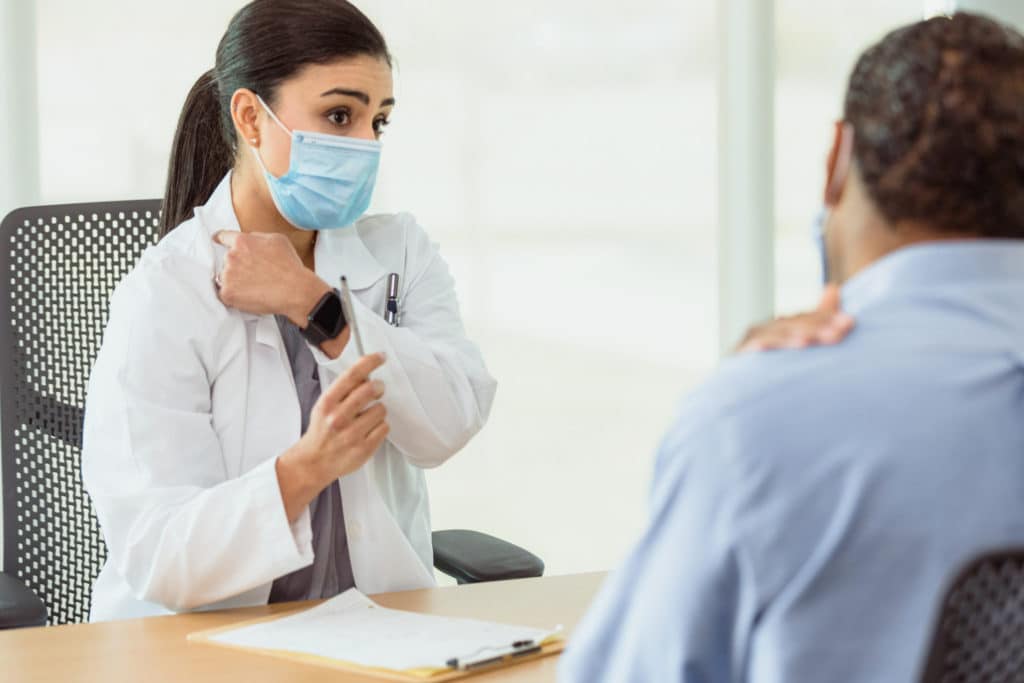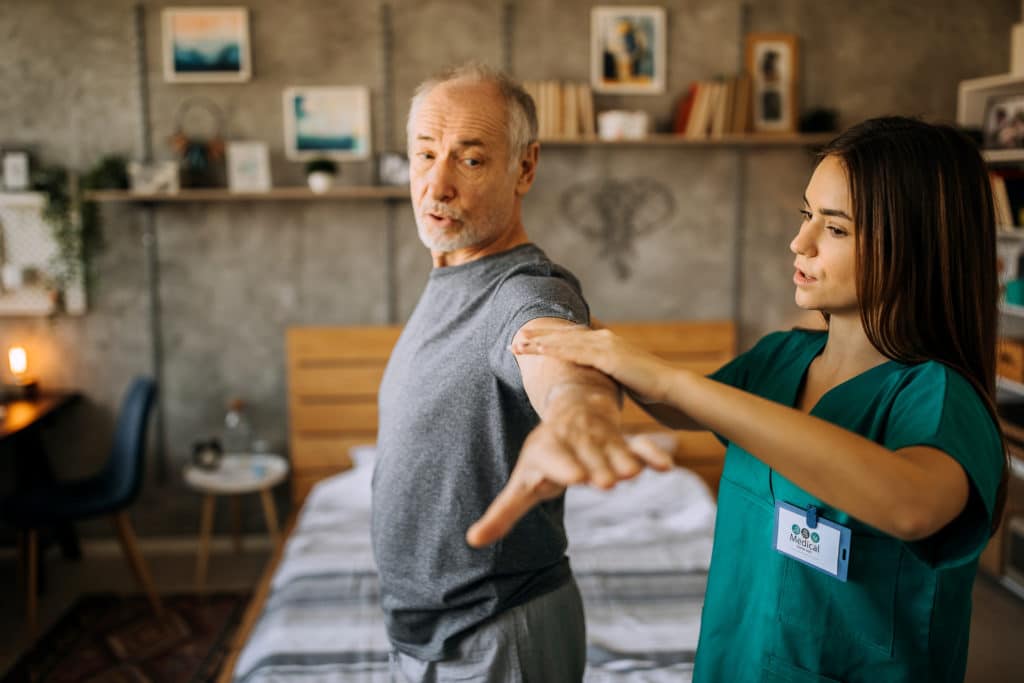

What Causes CRPS?
Learn how to diagnose CRPS and RSD in order to find the best route of treatment.
The information presented on this page is an overview of the average evaluation of chronic regional pain syndrome and is offered here as a resource. At J. Flowers Health Institute, our evaluations and treatment plans are customized and tailored to each individual’s needs. We specialize in providing a comprehensive team approach to your care. Our evaluations may include a chronic pain assessment, a medical evaluation, and a lifestyle assessment for help diagnosing your symptoms to provide the holistic care you deserve.
If you would like to learn more about J. Flowers Health Institute, please do not hesitate to reach out.
Table of Contents
Reach Out to Learn More
Complex Regional Pain Syndrome (CRPS)
Reflex Sympathetic Dystrophy Syndrome (RSD) is a medical condition in which people experience chronic pain in a body part (arm or leg), generally after a “significant” event such as an accident, stroke, or even a heart attack.
In RSD, the painful sensation experienced is usually more severe than what should be experienced from the injury. More recently, however, the term “Reflex Sympathetic Dystrophy Syndrome” is no longer generally used. Instead, the preferred term is Complex Regional Pain Syndrome (CRPS).1
RSD vs. CRPS: What is the Difference?
- Type 1: Also known as reflex sympathetic dystrophy
- Type 2: Formerly known as “Causalgia”3
Is RSD a Mental Illness?
Although RSD has been associated with some psychological disorders/illnesses and their symptoms, it’s quite challenging to get an exact classification. The DSM-IV contains a psychological illness class/category called “pain disorder,” which, like CRPS type I, is characterized by pain that isn’t fully explained by a physiologic process or a physical disorder.4
However, the fact is that the “exaggerated” pain levels experienced by people who have reflex sympathetic dystrophy are genuine and not just something that is “in their heads.” That is an important distinction to make to ensure that the condition is taken seriously and that stigmatization is avoided.
This is a vital step towards allocating and extending treatment to those afflicted. So, while RSD cannot be strictly classified as a mental illness, it’s usually accompanied by symptoms of mental conditions such as depression. It also has to be treated (to an extent) as a mental illness.
What Causes CRPS?
CRPS was once assumed to be a psychosomatic disorder with all the symptoms being “mental.” However, the exact cause of RSD syndrome is unknown, although it has been linked with dysfunction of the sympathetic nervous system.
Many cases of RSD are caused by injury or malfunction of damaged peripheral sensory neurons, which has subsequent consequences on the spinal cord and brain, disrupting signaling.5
RSD/CRPS Causes and Risk Factors
It’s still unknown why some persons with identical trauma experiences develop CRPS while others don’t. However, there are some common RSD pain causes and risk factors. They include:
Previous Injury
This is the risk factor most associated with complex regional pain syndrome. The syndrome appears to emerge within a month of sustaining a mild or more significant injury. These injuries can include any of the following:
- Fracture injuries
- Strains and sprains
- Burns
- Cuts
Usually, people heal from these injuries without any serious long-term effects, but persons with CRPS however, experience severe and persistent painful sensations. If not quickly diagnosed and treated, this pain could become progressive (i.e., spreading to affect other parts of the body).5
Surgery
There is also the possibility that RSD can occur from surgical procedures because of nerve damage from surgical incisions, retractors, placement, sutures, or postoperative scarring. However, the reason can be discovered and corrected in some cases, although CRPS can develop even when the surgical procedure is free of complications.
Other possible causes/risk factors of RSD syndrome include:
- Amputation
- Radiation
- Nerve damage because of “piercing injuries” caused by thin items like needle sticks
- Circulatory problems during wound healing
- Diabetes
- Genetics
- Poor nerve health
Signs and Symptoms of RSD
Due to possible differences in the causes of RSD in different people, it’s possible for a person not to exhibit all the RSD symptoms. However, people with RSD are likely to exhibit some of the signs and symptoms listed below:
- Exaggerated/elevated pain levels
- Skin texture changes
- Variations in the development patterns of the nails and hair
- Enhanced sensitivity to touch
- Differences in skin temperature
- Skin color changes (may be white, blue, or red)
- Inflammation and stiffness of the affected joint
- Edema
How Can RSD Impact Your Life?
Because RSD symptoms are usually severe, there is a high possibility that this condition will have an impact on and interfere with your normal daily routine. There is also the fact that chronic regional pain syndrome is usually accompanied by some psychological conditions such as anxiety, depression, or even post-traumatic stress disorder (PTSD).
This means that if you have the RSD medical condition, there is an increased likelihood that you’ll experience some symptoms of these mental illness conditions as well.6
RSD/CRPS Diagnosis
Due to its complexity and the fact that relatively little is known about it, there is no one specific RSD diagnosis test. The most common way to diagnose it is to rule out other illnesses that have similar symptoms. This allows treatment options to be the most relevant to the source of the diagnosis. Some of the tests that may be carried out include:
- Blood tests
- MRI scans
- X-rays
- Nerve conduction studies
- Skin appearance evaluation and temperature readings

Treatment for RSD at J. Flowers Health Institute
Although there is no specific “cure” available for CRPS, several CRPS treatment options have yielded positive results in several individuals. However, it should be noted that treatment for RSD is most effective when begun early. RSD diagnosis and treatment are very delicate. As such, it should be handled by seasoned healthcare professionals who will be able to diagnose and effectively manage the health condition accurately.
The J. Flowers Health Institute offers examinations and wellness programs for several conditions, including RSD. The institute has a therapeutic approach to health that is thorough, proactive, integrative, and centered on eliminating the fundamental cause of health problems so that patients can access the best care available.7
RSD treatment options offered at J. Flowers Health Institute include:
Physical Therapy
Physical therapy is the most effective therapy option available for the treatment of CRPS. This is because an individual can only avoid most of the physical and motor health complications associated with CRPS (such as muscle tightening and tissue atrophy) by using physical therapy to maintain flexibility, strength, and function of the painful limb or body part. Physical therapy also helps to promote blood flow.
Medications
There are also some medications that have been shown to yield significant success in the management and treatment of RSD and accompanying mental disorders. Note, however, that individual responses to these medications vary somewhat, with some people seeming to benefit more than others.
Examples of these medications include:
- Acetaminophen and NSAIDs
- Opioid analgesics like morphine and hydrocodone, which are particularly helpful when acetaminophen and NSAIDs cannot provide adequate pain relief
- Neuropathic pain relievers, such as gabapentin and pregabalin
- Topical anesthetics like lidocaine and fentanyl
- Corticosteroids
- Muscle relaxers
- Vasodilators
- Antidepressants
How to Cope with RSD?
Complex Regional Pain Syndrome does not have a cure, but there are several coping strategies you can employ alongside effective treatment that will ensure you can achieve optimal results. These strategies include the following.
Teamwork
Alternative Treatment
- Visualization and distraction
- Meditation
- Breathing exercises and stress reduction
- Yoga
- Increased intake of anti-inflammatory diets
If someone you know is struggling with this type of pain, there are various ways you can offer them help. Read on to learn more about how to help those around you with RSD/CRPS.
How to Help Someone With RSD?
It may be challenging to help someone with RSD for many reasons (both physical and psychological). Nevertheless, here are a couple of things you can do.
Offer Support
Understand that support doesn’t mean pity, and many people don’t like to be pitied. If you don’t know of any way to offer support, simply being available and accessible will speak volumes. Be willing to listen, help, and always seize every opportunity to show love to your loved one with RSD.
Ensure They Have Access to Professional Help
Several people are always unwilling to seek professional help and intervention, and this usually leads to further deterioration of the disease condition. RSD is a delicate condition that can worsen quickly, so you’ll want to make sure your loved one with RSD is receiving quality care in a specialist institution like J. Flowers Health Institute.
Get Help Today
If you or your loved one is suffering from RSD, reach out to J. Flowers Health Institute today to start effective treatment and enjoy relief from RSD pain.
References
- https://www.webmd.com/brain/what-is-reflex-sympathetic-dystrophy-syndrome#:~:text=Reflex%20sympathetic%20dystrophy%20syndrome%20
- https://www.ninds.nih.gov/health-information/disorders/complex-regional-pain-syndrome
- https://www.health.ny.gov/diseases/chronic/reflex_sympathetic/#:~:text=RSD%20is%20sometimes%20called%20Type,clearly%20associated%20with%20nerve%20injury.
- https://www.psychiatrictimes.com/view/crps-type-i-and-mental-illness
- https://www.nhs.uk/conditions/complex-regional-pain-syndrome/#:~:text=Causes%20of%20CRPS,but%20research%20has%20disproved%20this.
- https://www.e-acn.org/journal/view.php?number=618
- https://rsds.org/coping-strategies/





